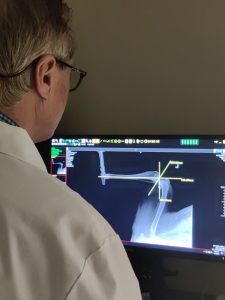Canine CCL surgery is more common then you think! Dogs can tear ligaments just like humans do, but luckily advances in veterinary science allows us to preform canine CCL surgeries almost weekly! Read on to learn more.
What is cranial cruciate ligament (CCL) disease?
The cranial cruciate ligament (CCL) is an important stabilizing structure in the knees (stifles) of dogs and cats. The CCL normally sits within the knee and is instrumental in assisting with articulation between the bones of the knee and joints. During normal function, the CCL prevents abnormal movement in the bones., while injury to the CCL allows abnormal movement of the bones. Injury to the CCL is common in dogs and results in abnormal laxity within the joint. Loss of stability of the knee leads to damage of structures within the knee and irreversible osteoarthritis.
Signs and Symptoms
Some of the clinical signs your pet may display are:
- Altered limb function (no weight-bearing or limping)
- Reluctance to bend the knee (may be seen while sitting)
- Stiffness, especially after exercise
- Not wanting to play or exercise
- Swelling of the joint
- Clicking sound when walking

Dr. Spinks uses x-ray technology to help assess each patient before surgery.
How is CCL disease diagnosed?
A veterinary examination is important to the diagnosis of CCL injury. Manipulations characteristic of knee instability can be done by your veterinarian and help with the diagnosis. Although the manipulations are not always painful to your pet, sedation provides relaxation and allows the veterinarian to examine the knee more thoroughly. X-rays will not show torn ligaments but may be done to support the diagnosis and establish changes within the knee (such as fluid within the knee and osteoarthritis).
What are my treatment options?
The goals for the treatment of CCL injury are to provide stability in the knee. This stability is designed to relieve pain, restore function and slow down the formation of osteoarthritis. Numerous surgical procedures have been described and studied, but no one treatment has been shown to be superior. Non-surgical options have been described, but are often difficult to control and can have a disappointing result in active dogs.
Though no one procedure is found to be superior, the prognosis for return to function and prevention of further damage is best attained with surgical stabilization of the knee. The decision on which procedure is performed is based on the surgeon’s experience with the technique, scientific data to support each technique, and patient suitability for the procedure.
Present techniques can be divided into broad categories. These categories are best described as those techniques that work to replace the function of the CCL, or techniques that use manipulation of the bones of the knee to provide stabilization. (Such as tibial plateau leveling osteotomy or tibial tuberosity advancement). Either procedure begins with a thorough exploration of the joint to address any other damage to internal structures of the knee (such as the meniscus).
SwiveLock Knotless technique
The SwiveLock Knotless technique is a minimally invasive technique that uses prosthetic materials designed to mimic the function of the CCL. The materials that sit on the outside of the knee (extra-articular) are secured using a vented PEEK SwiveLock Suture Anchor at points biomechanically similar to the CCL. This incredibly strong prosthetic material has been used with great success in human joint stabilizing procedures and is necessary for scar tissue formation and long-term joint stability and function.

The tightrope procedure requires exact measurement which is achieved through radiographs.

TPLO & TTA technique
Other techniques that provide stability through bone manipulation include the tibial plateau leveling osteotomy (TPLO) and the tibial tuberosity advancement (TTA). These procedures require cutting and alteration of the bone to provide weight-bearing stability. These procedures are options for those pets who have conformational issues that contribute to CCL injury and long-term stability.
It is important to recognize that there is not one procedure designed to fit every case. It is crucial that you work closely with your veterinarian to form a plan that best suits your pet. The process requires a complete examination, realistic goals, and a post-operative plan that allows for physical rehabilitation and rest. The commitment, regardless of surgical or non-surgical choice, requires 10-12 weeks for healing and is enhanced by seeking support from multiple sources.

Dr. Spinks explains that the SwiveLock and Tightrope procedures minimize the associated risk of the bone cutting procedures with similar or even better results. Complication rates are minimal with his technique and expertise developed over 15 years of doing the Arthrex procedures. If the bone cutting procedures such as the TPLO and TTA fail, it is often catastrophic resulting in amputation. However, Dr. Spinks does have experience repairing those fails and replacing them with Arthrex systems. The risk is minimalized with the Arthrex systems and if there is a complication, it can be corrected without an invasive procedure.
Post-op Care
It is extremely important to establish and follow a post-op plan with your veterinarian. It will most likely include restricted kennel rest when unobserved and controlled muscle-building activities (i.e., leash walking) for eight weeks post-op. Professional rehabilitation, such as hydrotherapy, is encouraged once the surgical site is completely healed. You can learn more about hydrotherapy here from the American Kennel Club.
The Arthrex Difference
Since 1984, Arthrex has been a privately held corporation committed to one thing; providing the finest quality products and educational services to meet the special needs of surgeons and their patients. Arthrex is dedicated to creative product development and medical education with an experienced, devoted team of professionals who are truly committed to continuing this long-term tradition. New product innovation in less invasive surgery is the heart and soul of Arthrex, which has resulted in the development of over 11,000 products for arthroscopic and minimally invasive orthopedic surgical procedures. Their goal is to make technically demanding surgical procedures easier, safer and reproducible.
Learn more:
Check out these videos from YouTube that show greater detail on both the Tightrope & SwiveLock techniques. Or click here to check out our other blog on ACL/CCL surgeries.


